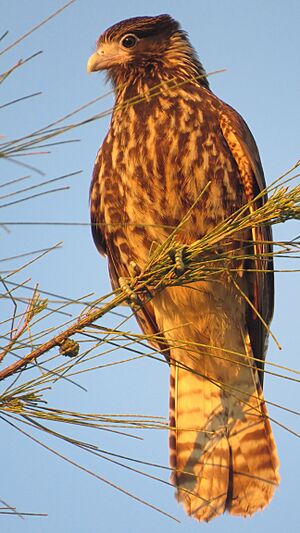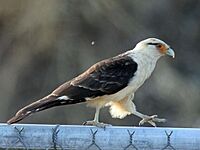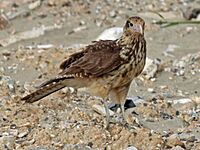Yellow-headed caracara facts for kids
The yellow-headed caracara is a cool bird of prey. It's part of the falcon family, but it's a bit different from the fast-flying falcons you might know. These birds are found in many parts of Central America and South America. They also live on some Caribbean islands. They like open areas like grasslands and farms.
Quick facts for kids Yellow-headed caracara |
|
|---|---|
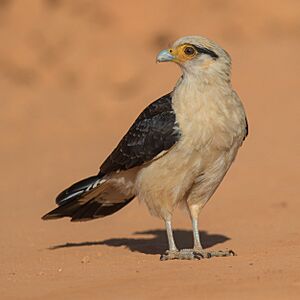 |
|
| Adult at Serra da Canastra National Park, Brazil | |
| Conservation status | |
| Scientific classification | |
| Genus: |
Milvago
|
| Species: |
chimachima
|
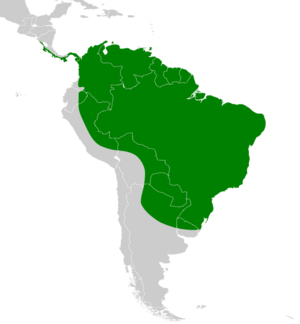 |
|
| Synonyms | |
|
|
Contents
About the Yellow-Headed Caracara's Family
Scientists like to group animals together. This helps us understand how they are related. The yellow-headed caracara was first named Polyborus chimachima by Louis Pierre Vieillot in 1816. Later, in 1824, another naturalist named Johann Baptist von Spix created a new group, Milvago, for this bird.
Different Ways to Group Caracaras
Today, most scientists agree that the yellow-headed caracara belongs to the Milvago group. This group also includes the chimango caracara. However, some groups of scientists have slightly different ideas about how to sort these birds. They might put the yellow-headed caracara in a group called Daptrius.
Yellow-Headed Caracara Subspecies
No matter how they are grouped, everyone agrees that the yellow-headed caracara has two main types, called subspecies. They are M. c. chimachima and M. c. cordata. There was also a larger, older type called M. c. readei. This type lived in Florida many thousands of years ago.
What Does the Yellow-Headed Caracara Look Like?
The yellow-headed caracara is a medium-sized bird. It is about 40 to 45 centimeters (16 to 18 inches) long. Males weigh around 277 to 335 grams (9.8 to 11.8 ounces). Females are a bit heavier, weighing 307 to 364 grams (10.8 to 12.8 ounces). Their wings can spread wide, from 74 to 95 centimeters (29 to 37 inches).
Adult Bird Colors
Both male and female yellow-headed caracaras look similar. Their heads, necks, and bellies are a creamy yellowish-white color. They have a thin dark stripe that goes through their eyes. Their backs and wings are dark brownish-black. When they fly, you can see a white patch on their wings. Their tail is yellowish with dark stripes and a black band near the end. Their eyes are reddish-brown. The skin around their eyes is bright yellow. Their legs and feet are a greenish color.
Young Bird Colors
Young yellow-headed caracaras look a bit different. Their upper parts are browner than the adults. Their bellies have brown streaks. The subspecies M. c. cordata has a darker yellowish color on its head and belly. It also has thinner stripes on its tail.
Where Do Yellow-Headed Caracaras Live?
The yellow-headed caracara lives in many places. The M. c. cordata subspecies is found in Nicaragua, Costa Rica, and most of Panama. It also lives in Colombia, Venezuela, and the Guianas. You can find it in Ecuador and Peru (east of the Andes mountains). It also lives across Brazil north of the Amazon River. Sometimes, these birds are seen as far north as Guatemala and Belize. They also live on islands like Aruba, Trinidad, and Tobago. They have visited Bonaire and Curaçao too.
Nominate Subspecies Range
The M. c. chimachima subspecies lives in eastern Bolivia. It also lives south through Paraguay and into northern Argentina. You can find it east through northern Uruguay and Brazil (south of the Amazon River). In some areas, like southern Brazil and northern Argentina, its home overlaps with the chimango caracara.
What Kind of Places Do They Like?
Yellow-headed caracaras prefer open areas with some trees. They like savannas, which are grasslands with scattered trees and palms. They are also common in ranchlands and pastures. You can find them near gallery forests, which are forests along rivers. They usually live from sea level up to about 1,000 meters (3,300 feet) high. Sometimes, they are seen even higher, around 2,500 meters (8,200 feet) in Colombia.
How Yellow-Headed Caracaras Behave
Movement and Travel
Yellow-headed caracaras usually stay in one place. They don't migrate far. However, some birds do wander to new areas. This is why they have been seen in northern Central America and on some islands. If people clear forests, these birds will move into the new open areas.
What Do Yellow-Headed Caracaras Eat?
These birds are omnivores, meaning they eat both plants and animals. They are very good at scavenging. This means they eat things they find, like dead animals (carrion). Their diet also includes insects, crabs, fish, reptiles, and small mammals. They eat bird eggs and baby birds too. They even eat horse dung, fruits like oil palm, coconuts, and corn.
They are known to pick ticks off cattle and other large animals like capybaras. Sometimes, they even make open wounds larger to get more food. They often walk on the ground to find food. But they also hunt while flying. They have been seen looking for small bugs in the fur of brown-throated three-toed sloths. Other birds don't seem to see them as a threat when they are feeding together.
Life Cycle and Reproduction
The time when yellow-headed caracaras nest changes depending on where they live. In Costa Rica, they nest from December to April. In Colombia, they might have two nesting seasons: January to April and July to September. In Venezuela, it includes August. Eggs have been found in May in Guyana, and in July and August in central Brazil. In southern Brazil, they lay eggs in September.
They usually build a nest out of sticks. They place it up to 15 meters (50 feet) high in a tree or palm. Sometimes, they nest in a tree hole. If there are no trees, they might nest on mounds in wet areas. They have even nested on the ground or in buckets on a house wall! A female usually lays one or two eggs, but sometimes four. The eggs hatch after about 22 days. The young birds leave the nest 17 to 20 days after hatching. They depend on their parents for about three more weeks. The female does most of the sitting on the eggs. Both parents feed the young birds.
What Sounds Do They Make?
Yellow-headed caracaras are quite noisy, especially when they are nesting. They also make sounds when they are fighting over food. Their most common calls are a scratchy, wailing "keeeah" or a longer "keeeeeeeee". They sometimes make these calls one at a time, but often repeat them. Other sounds they make include a growling "kraaa-kraaa-kraaa" or "krrrr-krrrr-krrrr". They also make a sharp "chay" and a thin, hissing whistle, "ksyeh, ksyeh."
Conservation Status
The IUCN (International Union for Conservation of Nature) has listed the yellow-headed caracara as a species of "Least Concern." This means that it is not in danger of disappearing. It lives in a very large area. Scientists believe there are at least five million adult birds. This number is thought to be growing. There are no immediate threats that could harm them. These birds will likely move into new lowland areas as forests are turned into farms or ranches.
Gallery



